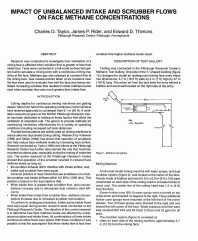Mining Publication: Impact of Unbalanced Intake and Scrubber Flows on Face Methane Concentrations
Original creation date: February 1997
Research was conducted to investigate how ventilation of a mining face is affected when scrubber flow is greater or less than intake flow. Tests were conducted in a full-scale surface test gallery built to simulate a mining entry with a continuous mining machine at the face. Methane gas was released at constant flow at the mining face. Gas measurements taken a six locations near the face were used to evaluate how well the face was being ventilated. Increasing scrubber flow resulted in lower methane levels even when scrubber flow was much greater than intake flow.
Authors: CD Taylor, JP Rider, ED Thimons
Conference Paper - February 1997
NIOSHTIC2 Number: 20027791
Proceedings of the 6th International Mine Ventilation Congress (May 17-22, 1997, Pittsburgh, Pennsylvania). Chapter 27, Ramani RV, ed., Littleton, CO: Society for Mining, Metallurgy, and Exploration, Inc., 1997 Feb; :169-172
See Also
- Comparison of Methane Concentrations at a Simulated Coal Mine Face During Bolting
- Development and Application of Reservoir Models and Artificial Neural Networks for Optimizing Ventilation Air Requirements in Development Mining of Coal Seams
- Effects of Water Sprays Used With a Machine-Mounted Scrubber on Face Methane Concentrations
- Guidelines for the Control and Monitoring of Methane Gas on Continuous Mining Operations
- Modeling and Prediction of Ventilation Methane Emissions of U.S. Longwall Mines Using Supervised Artificial Neural Networks
- Prediction of Longwall Methane Emissions and the Associated Consequences of Increasing Longwall Face Lengths: A Case Study in the Pittsburgh Coalbed
- Reservoir Modeling-Based Prediction and Optimization of Ventilation Requirements During Development Mining in Underground Coal Mines
- Simulation of Methane Flows in Noncoal Mines
- Technology News 465 - Method for Predicting Methane Emissions on Extended Longwall Faces
- Using Ultrasonic Anemometers to Evaluate Face Ventilation Conditions
- Page last reviewed: 7/20/2015
- Page last updated: 7/20/2015
- Content source: National Institute for Occupational Safety and Health, Mining Program


 ShareCompartir
ShareCompartir
